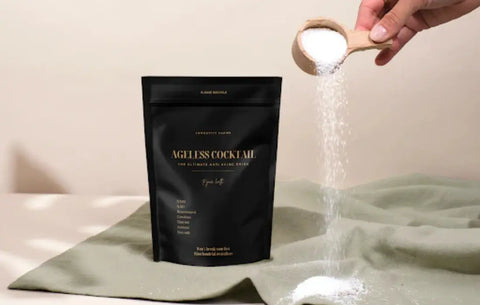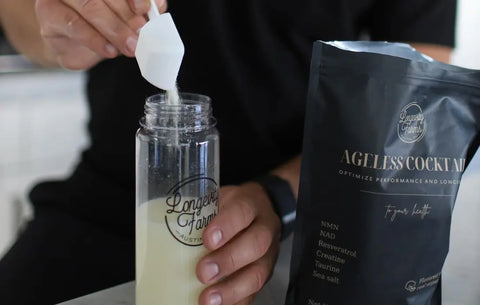Aging is a complex biological process characterized by the gradual decline of cellular functions. One of the hallmarks of aging is the accumulation of DNA damage over time, which gradually impairs cells' ability to function and divide. Our cells have evolved robust mechanisms for DNA repair to maintain genetic integrity, but these mechanisms themselves can influence the aging process. A key player in repairing DNA breaks is a family of enzymes known as PARP enzymes, which require a vital molecule called NAD⁺ to function correctly. NAD⁺ (nicotinamide adenine dinucleotide) is not only a coenzyme central to metabolism and energy production, but also a substrate used by both PARPs and sirtuins – proteins that regulate gene expression and longevity. Understanding how PARP enzymes, NAD⁺, and other factors interact provides insight into cellular aging and suggests potential strategies for promoting healthy aging.
What Are PARP Enzymes?
Poly(ADP-ribose) polymerases, or PARPs, are a family of enzymes that play a critical role in maintaining genome stability. PARP enzyme function revolves around detecting DNA strand breaks and initiating repair. When DNA in the cell nucleus is damaged (for example, by oxidative stress or radiation), PARP-1 – the most abundant member of this enzyme family – rapidly binds to the broken DNA and catalyzes the addition of ADP-ribose polymers to itself and various other proteins. This process, called poly(ADP-ribosyl)ation, uses NAD⁺ as a substrate and acts as a signal to recruit DNA repair machinery to the site of damage.

Historically, PARP enzymes have been primarily associated with chromosome maintenance; however, recent discoveries suggest that they also influence cellular metabolism and may even act as regulators of longevity. Beyond fixing DNA, PARPs can modulate cell signaling pathways and gene expression, intertwining with metabolic processes. For instance, PARP activity can affect the cell’s energy balance by consuming NAD⁺, an essential metabolic cofactor, during the repair reaction. There are many PARP family members (PARP-1, PARP-2, and others), but PARP-1 alone accounts for the majority of PARP activity in response to DNA damage. Without PARP-1, cells become highly sensitive to DNA damage, underscoring the pivotal role of PARP-mediated repair in cell survival.
The role of PARP in DNA repair is central to preventing mutations and maintaining cell viability. As soon as a single-strand break in DNA is detected, PARP-1 is activated and starts synthesizing long chains of ADP-ribose onto target proteins, including itself. This burst of poly(ADP-ribose) (PAR) formation relaxes the chromatin (the DNA-protein structure) around the break and serves as a beacon for other repair proteins to assemble. Think of PARP-1 as an emergency responder that arrives at the scene of DNA damage and sets off a molecular “alarm,” calling in the rest of the repair crew. Through this mechanism, PARP DNA repair activity helps cells quickly mend DNA single-strand breaks (and indirectly aids the repair of double-strand breaks as well via base excision repair pathways). This function is so crucial that researchers have observed a striking correlation between a species’ PARP activity levels and its lifespan: species with higher intrinsic PARP activity tend to live longer on average. Efficient PARP-driven repair capacity is associated with greater longevity, presumably because it enables better genome maintenance over time.
PARP1 as a Molecular Stress Sensor
PARP1 is not only a DNA repair enzyme but also serves as a highly sensitive molecular stress sensor within the cell nucleus. Its primary function is to detect and respond to various forms of molecular stress, especially those that threaten genome integrity. One of the key triggers for PARP1 activation is the presence of DNA strand breaks, which often arise from oxidative damage caused by reactive oxygen species (ROS). As cells age, their antioxidant defenses weaken, and ROS levels increase, leading to a higher frequency of DNA lesions. When PARP1 encounters these breaks, it binds directly to the damaged DNA and undergoes a dramatic increase in enzymatic activity, catalyzing the rapid synthesis of poly(ADP-ribose) (PAR) chains using NAD⁺ as a substrate. This PARylation event serves as both a signal to recruit DNA repair proteins and a regulator of chromatin structure, thereby facilitating access to the damaged site. PARP1 can also be activated by specific cellular stress signals that are independent of direct DNA damage, such as post-translational modifications or interactions with phosphorylated proteins. Throughout aging, chronic exposure to ROS and other stressors can lead to persistent PARP1 activation, which, while initially protective, may ultimately contribute to cellular dysfunction by depleting NAD⁺ and impairing metabolic resilience.
PARP, NAD⁺, and Aging
Given its role in DNA repair, it’s natural to ask how PARP and aging are connected. NAD primarily mediates the link⁺. PARP enzymes require NAD⁺ as a substrate to repair DNA, meaning every time PARP fixes damage, it consumes NAD⁺ and splits it into nicotinamide (vitamin B3) and ADP-ribose. If DNA damage is infrequent, this NAD⁺ consumption is minimal and easily replenished. But during aging, as cellular damage accumulates, PARP can become chronically activated. An abundance of DNA strand breaks will trigger continuous PARP activity, and consequently, the cell will use up more NAD⁺ than it can readily replace. Scientists often describe this as a tug-of-war between NAD aging processes: on one side, cells require NAD⁺ for routine metabolism and for longevity-associated enzymes, such as sirtuins; on the other side, rampant DNA damage forces NAD⁺ to be siphoned off for repair via PARP. Indeed, experiments show that when DNA damage triggers PARP-1, cellular NAD⁺ levels can drop rapidly as PARP adds ADP-ribose polymers to repair proteins. This NAD⁺ depletion can have a cascading effect. NAD⁺ is required for vital metabolic reactions and for sirtuin activity (as discussed in the next section), so excessive PARP activity might leave the cell with an energy deficit and silenced sirtuins – both of which can accelerate aspects of aging.
In very old age, the situation can flip: cells in elderly individuals often have chronically low NAD⁺ levels to begin with, due to factors such as reduced NAD⁺ synthesis and increased consumption by multiple enzymes throughout the lifespan. When NAD⁺ is in short supply, the PARP enzyme function itself becomes impaired. This illustrates the intimate connection between PARP and NAD: an optimal level of NAD⁺ is needed to sustain DNA repair in aging cells, and maintaining DNA repair capability is, in turn, important for healthy aging. If one could naturally lower PARP activity by addressing the underlying causes of DNA damage, it would prevent unnecessary NAD⁺ depletion.
PARP1 and Inflammation in Aging
Beyond its well-known function in DNA repair, PARP1 plays a direct and influential role in the inflammatory processes that accompany aging. As organisms age, chronic, low-grade inflammation—often referred to as "inflammaging"—becomes more prevalent and is now recognized as a significant contributor to age-related diseases. PARP1 is intricately involved in this process through its unique ability to serve as a transcriptional cofactor for NF-κB, a master regulator of inflammatory gene expression.
NF-κB is a redox-sensitive transcription factor that controls the expression of numerous pro-inflammatory cytokines, chemokines, and adhesion molecules. Under normal conditions, NF-κB is kept inactive in the cytoplasm. Still, in response to cellular stressors such as oxidative damage or DNA breaks—both of which increase with age—NF-κB is activated and translocates to the nucleus. Here, PARP1 acts as a coactivator, physically associating with NF-κB at the promoters of target genes. This partnership enhances the transcriptional response, resulting in increased production of inflammatory mediators, including TNF-α, IL-6, and MCP-
During aging, persistent DNA damage and oxidative stress can cause chronic PARP1 activation, which in turn sustains excessive NF-κB activity. This creates a feedback loop: PARP1 enhances NF-κB-driven inflammation, while the resulting inflammatory milieu generates more reactive oxygen species and DNA damage, further activating PARP1. This cycle contributes to the establishment and maintenance of chronic inflammation in aged tissues.
PARP1’s Role in Gene Expression Regulation
When activated by cellular stress or DNA damage, PARP1 catalyzes the transfer of ADP-ribose units from NAD⁺ onto itself and other nuclear proteins. This modification, known as poly(ADP-ribosyl)ation, can alter chromatin structure, making DNA more accessible to transcription factors like NF-κB and facilitating the assembly of transcriptional complexes at target gene promoters. However, research has produced nuanced insights into the necessity of PARP1’s catalytic activity for NF-κB-mediated transcription. The physical presence of PARP1 at gene promoters, rather than its enzymatic function, is sufficient to enhance NF-κB-dependent gene expression. In these cases, PARP1 acts as a coactivator, stabilizing the transcriptional machinery and promoting efficient gene activation.
The implications of PARP1-mediated gene regulation extend well beyond inflammation. As organisms age, chronic activation of PARP1—whether through persistent DNA damage or metabolic stress—can reshape the cellular transcriptome, affecting genes involved in stress responses, metabolism, and cellular senescence. This broad regulatory capacity means that PARP1 not only amplifies inflammatory signals but also contributes to the global reprogramming of gene expression seen in aging tissues. Understanding the dual roles of PARP1 in gene regulation offers new insights into how age-related changes in its activity may influence or mitigate various aspects of cellular aging.
Therapeutic Targeting of PARP in Age-Associated Diseases
The concept of therapeutically targeting PARP enzymes, particularly PARP1, has garnered considerable attention as a strategy for treating age-associated diseases and mitigating age-related cellular damage. PARP inhibitors are small molecules designed to block the enzymatic activity of PARP, limiting the excessive consumption of NAD⁺ and preventing the cascade of events that can lead to cellular dysfunction and tissue degeneration. Originally developed for cancer therapy, PARP inhibitors are now being explored for their potential benefits in a broader range of age-related conditions, including neurodegenerative disorders, cardiovascular diseases, and chronic inflammatory states.
NAD⁺ and Cellular Aging
NAD⁺ is often described as a central currency of metabolism and a linchpin in the aging process. This molecule is found in every cell and is crucial for converting nutrients into cellular energy (ATP) through metabolic pathways. Beyond its metabolic role, NAD⁺ serves as a cofactor for many enzymes that regulate aging and stress resistance. Cells with low NAD⁺ have a harder time producing energy and activating their built-in maintenance systems, leading to fatigue on a cellular level and poorer stress response. NAD⁺ depletion has been linked to many age-related issues such as impaired DNA repair, mitochondrial dysfunction, and neurodegeneration.
The encouraging news is that restoring NAD⁺ has shown rejuvenating effects in animal studies. Experimental evidence demonstrates that raising NAD⁺ levels in old mice – typically by giving precursors of NAD⁺ as supplements – can boost NAD levels back up and improve cell function. Mice receiving such NAD⁺ boosters exhibit improved mitochondrial activity, enhanced DNA repair, and even increased lifespan in some cases. In short, maintaining NAD⁺ appears to help cells act “younger” and more resilient. This has spurred interest in therapies and lifestyle interventions to slow cellular aging by sustaining NAD⁺.

NAD⁺ and Sirtuins: The Longevity Connection
One of the most fascinating discoveries in aging biology is the relationship between NAD and sirtuins. Sirtuins are a family of enzymes (SIRT1 through SIRT7 in mammals) that regulate a range of processes related to aging, including DNA repair, inflammation, metabolism, and cell survival. What makes sirtuins unique is that they are NAD⁺-dependent deacetylases: they use NAD⁺ to remove acetyl groups from proteins, altering the activity of those proteins. Sirtuins sense the cell’s NAD⁺ status and translate it into changes in gene expression and protein function that can promote longevity. SIRT1, the most studied sirtuin, targets many proteins, including the master regulator PGC-1α (which controls mitochondrial biogenesis) and the tumor suppressor p53. By deacetylating these targets, SIRT1 helps enhance mitochondrial function, reduce oxidative stress, and improve genomic stability – all of which are beneficial for aging cells. The catch is that sirtuins are only active when NAD⁺ is available. If NAD⁺ levels fall, sirtuin activity diminishes.
PARP enzymes, particularly PARP-1 and PARP-2, directly influence the activity of SIRT1, one of the most important sirtuins for maintaining cellular health and longevity. While both enzyme families require NAD⁺ to function, their interaction goes beyond simple competition for this shared resource. PARP-1, when activated in response to DNA damage, consumes large amounts of NAD⁺, thereby reducing its availability for SIRT1. This NAD⁺ depletion leads to diminished SIRT1 activity, which can impair mitochondrial function, reduce stress resistance, and slow cellular repair processes—factors closely linked to aging. In contrast, PARP-2 affects SIRT1 through a different mechanism: it binds directly to the promoter region of the SIRT1 gene, repressing its transcription and resulting in lower SIRT1 protein levels within the cell.
It’s worth noting that sirtuins and PARP appear to compete for the same NAD⁺ pool in cells. When PARP is overactivated, it can monopolize NAD⁺ and produce nicotinamide as a byproduct. Nicotinamide itself can then act as a feedback inhibitor of sirtuins. Thus, chronic DNA damage and PARP activation may counteract the benefits of sirtuins via NAD⁺ depletion and nicotinamide accumulation. This intricate balance underlies why preserving NAD⁺ is so critical for aging: NAD⁺ fuels the adaptive, protective programs (like sirtuins) that keep cells healthy, but is also needed to fix DNA lesions through PARP. Effective longevity strategies may require maintaining NAD⁺ levels at a sufficiently high level to meet both demands.
Lowering PARP Activity Naturally
Considering the tug-of-war between PARP-mediated repair and sirtuin-driven maintenance for NAD⁺, a reasonable question is whether we can temper PARP activity to preserve NAD⁺. Here are several natural strategies:
-
Avoid Excessive UV and Toxin Exposure: Ultraviolet radiation and environmental toxins like cigarette smoke, air pollution, or certain chemicals can inflict DNA damage. Limiting exposure to these can reduce the burden of DNA strand breaks that PARP needs to repair. For example, wearing sunscreen and not smoking are simple ways to protect your DNA and indirectly ease PARP’s workload in skin and lung cells, respectively.
-
Adopt an Antioxidant-Rich Diet: A lot of DNA damage in cells is caused by reactive oxygen species (ROS) – essentially free radicals produced by normal metabolism or stress. Consuming a diet high in natural antioxidants can help neutralize ROS before they damage DNA. Colorful fruits and vegetables (berries, leafy greens, etc.) provide vitamins C and E, carotenoids, and polyphenols that reduce oxidative DNA hits. By lowering oxidative stress, an antioxidant-rich diet curtails the continuous activation of PARP for oxidative DNA lesions.
-
Exercise Regularly (in Moderation): While extreme exercise can cause transient increases in oxidative stress, moderate exercise induces a long-term adaptive response where cells upregulate repair enzymes and antioxidants. This means over time, a person who exercises moderately may accumulate less DNA damage at rest and have more efficient repair systems. Improved metabolic health from exercise also reduces chronic inflammation.
-
Manage Stress and Get Adequate Sleep: Chronic psychological stress and poor sleep quality have been linked to increased oxidative stress and DNA damage markers. Stress hormones can indirectly generate ROS, and insufficient sleep impairs the nighttime cellular maintenance processes (including DNA repair) that generally occur. By practicing stress-reduction techniques (like meditation or yoga) and maintaining good sleep hygiene, you can help lower baseline DNA damage. This means your cells won’t need to activate PARP as often to respond to stress-induced damage.
-
Maintain a Healthy Metabolism: High blood sugar and chronic inflammation, such as that seen in metabolic syndrome or diabetes, produce DNA-damaging byproducts (e.g., advanced glycation end-products and more ROS). Maintaining a healthy weight and balanced blood sugar through diet (low in processed sugars) can reduce these internal DNA assaults. Some evidence even suggests that mild caloric restriction or intermittent fasting – done responsibly – can decrease molecular damage and simultaneously boost NAD⁺ levels, creating a more favorable environment for both low PARP activation and high sirtuin activity.
By implementing these habits, one can effectively lower PARP activity naturally, as there are simply fewer DNA breaks for PARP to repair on a day-to-day basis. The benefit is two-fold: genome stability is preserved, and NAD⁺ stores are not constantly drained, leaving more NAD⁺ available to support vital metabolic and longevity pathways.
Nutrients and Supplements to Support DNA Repair
Just as lifestyle choices impact DNA damage and repair, so too does nutrition. The cells’ capacity to repair DNA can be bolstered by specific vitamins, minerals, and other compounds that serve as necessary cofactors or protective agents. Many people wonder about supplements to support DNA repair – which nutrients make a difference? Below are some key nutrients and compounds known to aid DNA repair and genomic stability:
-
B Vitamins (Folate, B12, B6, Niacin): Folate and vitamin B12 are required for the synthesis of nucleotides (the building blocks of DNA) and for one-carbon metabolism, which influences DNA methylation and repair. A deficiency in these can lead to uracil misincorporation into DNA or impaired repair of DNA strands. Vitamin B6 is also involved in DNA synthesis pathways. Niacin (vitamin B3) deserves special mention – it is directly related to NAD⁺ production via the salvage pathway (niacin converts to NAD⁺ in cells). Adequate niacin or its derivative nicotinamide supports the pool of NAD⁺ available for PARP and sirtuins, thereby indirectly aiding DNA repair and cell survival after damage.
-
Minerals (Zinc and Selenium): Zinc plays a structural and catalytic role in many DNA-associated proteins. For instance, the p53 tumor suppressor and several DNA repair enzymes require zinc to maintain their proper shape and function. Low zinc status in the body has been linked to increased DNA strand breaks. Selenium, on the other hand, is a component of antioxidant enzymes, such as glutathione peroxidase, that help mitigate oxidative stress.
-
Antioxidant Vitamins (A, C, and E): These vitamins help quench free radicals and reactive oxygen species that can attack DNA bases and cause breaks. Vitamin C functions in aqueous environments, such as the cell cytosol and nucleus, to directly scavenge radicals. It has even been shown to stimulate certain DNA repair enzymes in cell culture. Vitamin E (tocopherols and tocotrienols) is lipid-soluble and protects cell membranes (and the DNA within) from lipid peroxidation chain reactions. Vitamin A (including beta-carotene as a precursor) supports skin and mucosal health and has antioxidant properties; it is also essential for proper cell differentiation, which can influence how effectively cells respond to damage. In combination, these antioxidants reduce the amount of damage that occurs, which means cells have less to repair and can keep up with the damage that does happen.
-
Polyphenols and Other Phytochemicals: Various plant-derived compounds have shown potential in supporting DNA integrity. Curcumin (from turmeric) can activate specific DNA repair pathways and is a strong anti-inflammatory agent, which may indirectly reduce DNA damage from chronic inflammation. Resveratrol (found in red grapes and also in supplements) is famously known for activating sirtuin enzymes like SIRT1, which can improve DNA stability and cell survival under stress. Resveratrol has also been observed to inhibit some types of oxidative damage. Other polyphenols, such as epigallocatechin gallate (EGCG) from green tea or proanthocyanidins from grape seed extract, are potent antioxidants that localize in the nucleus and mitochondria, safeguarding DNA from various insults.
For most people, eating a balanced diet rich in fruits, vegetables, whole grains, and lean proteins should provide these essential nutrients to support DNA repair.
NAD⁺ Boosters and Anti-Aging Supplements
Perhaps the most exciting area of longevity research in recent years has been the focus on NAD⁺ boosters – interventions designed to increase the body's NAD⁺ levels. Because NAD⁺ is so pivotal for energy metabolism, DNA repair, and sirtuin activity, raising its levels is seen as a promising way to counteract some aspects of aging. Several compounds have emerged as effective NAD booster supplements, and they are sometimes touted as anti-aging pills due to their potential to rejuvenate cellular function. The two leading NAD⁺ precursors in this arena are nicotinamide mononucleotide (NMN) and nicotinamide riboside (NR). NR and NMN are vitamin B3 (niacin) derivatives that serve as direct building blocks for NAD⁺. When you ingest NR or NMN, your cells convert them through a series of steps into NAD⁺, increasing the NAD⁺ pool available for all the important processes we’ve discussed. NMN is a slightly larger molecule, but it is one step closer to NAD⁺ in the synthesis pathway, whereas NR needs to be converted into NMN inside the cell before it can become NAD⁺.

When considering NAD⁺ boosters, it’s important to note that you cannot directly buy NAD and ingest it to raise NAD⁺ levels – NAD⁺ as a molecule is too large and unstable to survive the digestive process. Instead, one must buy NMN supplements or NR supplements, which are available as oral pills or powders, to deliver NAD⁺ precursors into the body effectively. These supplements are generally viewed as an extension of the vitamin B3 family. High-dose niacin (vitamin B3 in the form of nicotinic acid) can also boost NAD⁺, but it often causes an uncomfortable flushing reaction, and its metabolite (nicotinamide) can inhibit sirtuins if it accumulates, making NMN and NR more attractive for anti-aging purposes.
Other novel compounds and approaches are being explored to boost NAD levels. One approach is inhibiting enzymes that break down NAD⁺. Natural inhibitors of CD38 (an NADase enzyme that increases with age in some tissues) might help spare more NAD⁺ for beneficial uses. Another approach is to provide other precursors, such as nicotinamide (niacinamide) or tryptophan (an amino acid that can be converted to NAD⁺ via the de novo pathway). However, these are less efficient or have side effects at high doses. NAD⁺ IV infusions have also become a trend in some wellness clinics, but the practicality and long-term benefits of this method are still under investigation, and it’s much less convenient than taking a pill.
For most people interested in longevity, oral NAD⁺ precursors serve as the primary entry point. Consumers considering these supplements should look for quality and purity, as the market is relatively new. For instance, Longevity Farms specializes in science-backed dietary supplements, with their flagship Ageless Cocktail, which is a daily drink mix formulated with NAD, NMN, resveratrol, creatine, amino acids, L-taurine, and sea salt. It is designed to boost energy, clarity, and promote youthful skin.
The interplay of PARP enzymes, NAD⁺, and cellular aging provides a clear example of how the maintenance of our genetic and metabolic health is deeply connected. PARP enzymes safeguard our DNA by repairing damage, but in doing so, they rely on NAD⁺, a molecule that also fuels metabolic and longevity pathways. As we age and face more oxidative and environmental stress, DNA damage increases, and PARP activity can become a double-edged sword – necessary for repair, but costly in terms of NAD⁺ consumption. This can create a vicious cycle where low NAD⁺ further hampers both DNA repair and the activity of beneficial proteins like sirtuins, accelerating cellular aging. However, understanding this cycle enables us to intervene in it. By leading a lifestyle that minimizes avoidable DNA damage and by ensuring ample availability of NAD⁺, we can support our cells’ natural repair and longevity mechanisms.
Sources
-
Interference between PARPs and SIRT1: a novel approach to healthy ageing? – Aging (Albany NY), 2011
-
The NAD⁺/PARP1/SIRT1 Axis in Aging – Rejuvenation Research, 2017
-
It takes two to tango: NAD⁺ and sirtuins in aging/longevity control – npj Aging and Mechanisms of Disease, 2016
-
Extracellular NAD⁺ enhances PARP-dependent DNA repair capacity independently of CD73 activity – Scientific Reports, 2020
-
Protective Effects of Micronutrient Supplements and Phytochemicals Against DNA Damage in Humans – A Systematic Review – Advances in Nutrition, 2023
-
The efficacy and safety of β-nicotinamide mononucleotide (NMN) supplementation in healthy middle-aged adults – Geroscience, 2023




